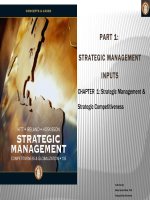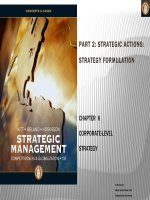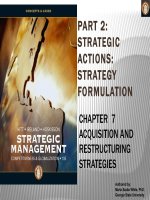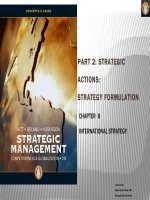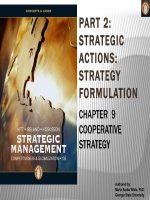Chapter 12 strategic management competitiveness and globalization 10e
Bạn đang xem bản rút gọn của tài liệu. Xem và tải ngay bản đầy đủ của tài liệu tại đây (789.48 KB, 48 trang )
PART 3: STRATEGIC
ACTIONS:
STRATEGY IMPLEMENTATION
CHAPTER 12
STRATEGIC LEADERSHIP
Authored by:
Marta Szabo White, PhD.
Georgia State University
THE STRATEGIC MANAGEMENT PROCESS
©2013 Cengage Learning. All Rights Reserved. May not be copied, scanned, or duplicated, in whole or in part, except for use as permitted in a license distributed with a certain product or service or otherwise on a passwordprotected website for classroom use.
KNOWLEDGE OBJECTIVES
● Define strategic leadership and describe top-level managers’
importance.
● Explain what top management teams are and how they affect
firm performance.
● Describe the managerial succession process using internal
and external managerial labor markets.
● Discuss the value of strategic leadership in determining the
firm’s strategic direction.
©2013 Cengage Learning. All Rights Reserved. May not be copied, scanned, or duplicated, in whole or in part, except for use as permitted in a license distributed with a certain product or service or otherwise on a passwordprotected website for classroom use.
KNOWLEDGE OBJECTIVES
● Describe the importance of strategic leaders in managing the
firm’s resources.
● Define organizational culture and explain what must be done
to sustain an effective culture.
● Explain what strategic leaders can do to establish and
emphasize ethical practices.
● Discuss the importance and use of organizational controls.
©2013 Cengage Learning. All Rights Reserved. May not be copied, scanned, or duplicated, in whole or in part, except for use as permitted in a license distributed with a certain product or service or otherwise on a passwordprotected website for classroom use.
OPENING CASE
SUCCESSION AT HP: CAN THE NEW CEO SAVE THE COMPANY’S SOUL?
■ HP’s culture of innovation suffered under Mark Hurd, the former CEO’s leadership.
■
Hurd was efficiency oriented and had made the company money by tightly
controlling costs.
■ Former SAP CEO Leo Apotheker was named as CEO successor and had the
opportunity to “reboot” the company and its culture.
©2013 Cengage Learning. All Rights Reserved. May not be copied, scanned, or duplicated, in whole or in part, except for use as permitted in a license distributed with a certain product or service or otherwise on a passwordprotected website for classroom use.
OPENING CASE
SUCCESSION AT HP: CAN THE NEW CEO SAVE THE COMPANY’S SOUL?
■ Having lost its culture of innovation, HP’s strategic redirection into software and
cloud computing needed to be successful.
■ With a merciless market, the expectation of strong performance exists even
though major strategic changes take time to produce fruitful results.
■
Apotheker’s strategic leadership is being tested in the midst of layoff rumors and
profit target reductions.
©2013 Cengage Learning. All Rights Reserved. May not be copied, scanned, or duplicated, in whole or in part, except for use as permitted in a license distributed with a certain product or service or otherwise on a passwordprotected website for classroom use.
INTRODUCTION
● Effective strategic leadership is the foundation for
successfully using the strategic management process.
● Strategic leaders guide the firm in ways that result in
forming a vision and mission.
●
This guidance often finds leaders thinking of ways to
create goals that stretch everyone in the organization
to improve performance.
●
Moreover, strategic leaders facilitate the development
of appropriate strategic actions and determine how to
implement them.
● Leaders can make a major difference in how a firm
performs.
©2013 Cengage Learning. All Rights Reserved. May not be copied, scanned, or duplicated, in whole or in part, except for use as permitted in a license distributed with a certain product or service or otherwise on a passwordprotected website for classroom use.
STRATEGIC LEADERSHIP AND STYLE
Strategic leadership: the ability to anticipate, envision, maintain
flexibility, and empower others to create strategic change as
necessary
• Multifunctional task
•
•
•
•
Managing through others
Managing an entire enterprise rather than a functional subunit
Coping with change that is increasing in the global economy
Most critical skill: attracting and managing human (includes intellectual)
capital
NOTE: Many examples of well-known CEOs are mentioned throughout the
chapter to illustrate their leadership styles.
©2013 Cengage Learning. All Rights Reserved. May not be copied, scanned, or duplicated, in whole or in part, except for use as permitted in a license distributed with a certain product or service or otherwise on a passwordprotected website for classroom use.
STRATEGIC LEADERSHIP AND STYLE
FIGURE 12.1
Strategic Leadership and
the Strategic
Management Process
©2013 Cengage Learning. All Rights Reserved. May not be copied, scanned, or duplicated, in whole or in part, except for use as permitted in a license distributed with a certain product or service or otherwise on a passwordprotected website for classroom use.
STRATEGIC LEADERSHIP AND STYLE
EFFECTIVE STRATEGIC LEADERS
•
Build strong ties with external stakeholders to gain access to information and advice
• Understand how their decisions impact their firm
• Sustain above-average performance
• Attract and manage human capital
• Do not delegate decision-making responsibilities
• Inspire and enable others to do excellent work and realize their potential
• Promote and nurture innovation through transformational leadership
©2013 Cengage Learning. All Rights Reserved. May not be copied, scanned, or duplicated, in whole or in part, except for use as permitted in a license distributed with a certain product or service or otherwise on a passwordprotected website for classroom use.
THE ROLE OF TOP-LEVEL MANAGERS
● Managers use their discretion when making strategic decisions
● Primary factors that determine the amount of a manager’s decisionmaking discretion
• External environmental sources
• Organization’s characteristics
• Manager’s characteristics
©2013 Cengage Learning. All Rights Reserved. May not be copied, scanned, or duplicated, in whole or in part, except for use as permitted in a license distributed with a certain product or service or otherwise on a passwordprotected website for classroom use.
FACTORS AFFECTING MANAGERIAL DISCRETION
FIGURE 12.2
Factors Affecting
Managerial Discretion
©2013 Cengage Learning. All Rights Reserved. May not be copied, scanned, or duplicated, in whole or in part, except for use as permitted in a license distributed with a certain product or service or otherwise on a passwordprotected website for classroom use.
FACTORS AFFECTING MANAGERIAL DISCRETION
External
Environment
•
•
•
•
•
Industry structure
Rate of market growth
Number and type of competitors
Nature and degree of political/legal
constraints
Degree to which products can be
differentiated
©2013 Cengage Learning. All Rights Reserved. May not be copied, scanned, or duplicated, in whole or in part, except for use as permitted in a license distributed with a certain product or service or otherwise on a passwordprotected website for classroom use.
FACTORS AFFECTING MANAGERIAL DISCRETION
External
Environment
Characteristics of
the Organization
•
•
•
•
•
Size
Age
Culture
Availability of resources
Patterns of interaction among
employees
©2013 Cengage Learning. All Rights Reserved. May not be copied, scanned, or duplicated, in whole or in part, except for use as permitted in a license distributed with a certain product or service or otherwise on a passwordprotected website for classroom use.
FACTORS AFFECTING MANAGERIAL DISCRETION
External
Environment
Characteristics of
the Organization
•
•
•
•
•
Tolerance for ambiguity
Commitment to the firm and its desired
strategic outcomes
Interpersonal skills
Aspiration level
Degree of self-confidence
Characteristics of
the Manager
©2013 Cengage Learning. All Rights Reserved. May not be copied, scanned, or duplicated, in whole or in part, except for use as permitted in a license distributed with a certain product or service or otherwise on a passwordprotected website for classroom use.
FACTORS AFFECTING MANAGERIAL DISCRETION
External
Environment
•
The degree of latitude for action when
making strategic decisions, especially
those concerned with effective
implementation of strategies
Characteristics of
•
How managers exercise discretion when
determining appropriate strategic
actions is critical to the firm’s success
the Organization
Characteristics of
the Manager
Managerial
Discretion
©2013 Cengage Learning. All Rights Reserved. May not be copied, scanned, or duplicated, in whole or in part, except for use as permitted in a license distributed with a certain product or service or otherwise on a passwordprotected website for classroom use.
TOP MANAGEMENT TEAMS
Top Management Teams
• Help avoid potential problem of CEO making decisions
•
alone: managerial hubris
• Hubris: excessive pride leading to a feeling of invincibility
• Hubris can magnify the effects of decision-making biases
Composed of key individuals who are responsible for
selecting and implementing firm’s strategies; usually
includes officers of the corporation (VP and above)
and BOD
©2013 Cengage Learning. All Rights Reserved. May not be copied, scanned, or duplicated, in whole or in part, except for use as permitted in a license distributed with a certain product or service or otherwise on a passwordprotected website for classroom use.
TOP MANAGEMENT TEAM, FIRM PERFORMANCE, AND
STRATEGIC CHANGE
Heterogeneous team: individuals with varied functional backgrounds,
experiences, and education
Team members: bring a variety of strengths, capabilities, and
knowledge and provide effective strategic leadership when faced with
complex environments and multiple stakeholder relationships to
manage
©2013 Cengage Learning. All Rights Reserved. May not be copied, scanned, or duplicated, in whole or in part, except for use as permitted in a license distributed with a certain product or service or otherwise on a passwordprotected website for classroom use.
TOP MANAGEMENT TEAM, FIRM PERFORMANCE, AND
STRATEGIC CHANGE
A HETEROGENEOUS TEAM
• Introduces a variety of perspectives
• Has a greater propensity for strong competitive action
• “Outside of the box thinking," leads to more creative decision making,
innovation, and strategic change
• Offers various areas of expertise to identify environmental opportunities,
threats, or the need for change
• Promotes debate, which leads to better strategic decisions, and higher firm
performance
• May take longer to reach consensus
©2013 Cengage Learning. All Rights Reserved. May not be copied, scanned, or duplicated, in whole or in part, except for use as permitted in a license distributed with a certain product or service or otherwise on a passwordprotected website for classroom use.
THE CEO AND TOP MANAGEMENT TEAM POWER
Higher performance is achieved when the board of
directors (BOD) is more directly involved in shaping
strategic direction
A powerful CEO may:
• Appoint sympathetic outside board members
• Have inside board members who report to the
CEO
• Have long tenure, thus have greater influence
on board decisions
• Be virtually independent of oversight by the
BOD
• May also hold the position of chairman of the
board (CEO duality)
©2013 Cengage Learning. All Rights Reserved. May not be copied, scanned, or duplicated, in whole or in part, except for use as permitted in a license distributed with a certain product or service or otherwise on a passwordprotected website for classroom use.
THE CEO AND TOP MANAGEMENT TEAM POWER
CEO Duality – CEO serves as CEO and BOD
• More common in the United States
• Occurs most often in the largest firms
• Increased shareholder activism recently brought the
•
practice under scrutiny
Criticized for causing poor performance and slow
response to change
BALANCE OF POWER BETWEEN THE BOD AND TOP MANAGEMENT
IMPACTED BY:
• Resource abundance
• Environmental volatility and uncertainty
©2013 Cengage Learning. All Rights Reserved. May not be copied, scanned, or duplicated, in whole or in part, except for use as permitted in a license distributed with a certain product or service or otherwise on a passwordprotected website for classroom use.
MANAGERIAL SUCCESSION
DEFINITION: preselect and shape the skills of
tomorrow’s leaders
• Internal managerial labor market: opportunities for
•
managerial positions to be filled from within the firm
External managerial labor market: opportunities for
managerial positions to be filled by candidates from outside
of the firm
• This decision impacts company performance and
•
the ability to embrace change in today's
competitive landscape
Succession, top management team composition,
and strategy are intimately related
©2013 Cengage Learning. All Rights Reserved. May not be copied, scanned, or duplicated, in whole or in part, except for use as permitted in a license distributed with a certain product or service or otherwise on a passwordprotected website for classroom use.
EFFECTS OF CEO SUCCESSION AND TOP MANAGEMENT TEAM
COMPOSITION ON STRATEGY
FIGURE 12.3
Effects of CEO Succession
and Top Management
Team Composition on
Strategy
©2013 Cengage Learning. All Rights Reserved. May not be copied, scanned, or duplicated, in whole or in part, except for use as permitted in a license distributed with a certain product or service or otherwise on a passwordprotected website for classroom use.
MANAGERIAL SUCCESSION
Benefits of Internal Managerial Labor Market
•
•
•
•
•
•
Continuity
Continued commitment
Familiarity
Reduced turnover
Retention of “private knowledge”
Favored when the firm is performing well
©2013 Cengage Learning. All Rights Reserved. May not be copied, scanned, or duplicated, in whole or in part, except for use as permitted in a license distributed with a certain product or service or otherwise on a passwordprotected website for classroom use.
MANAGERIAL SUCCESSION
Benefits of External Managerial Labor Market
• Long tenure with the same firm is thought to reduce
innovation
• Outsiders bring diverse knowledge bases and social
networks, which offer the potential for synergy and new
competitive advantages
• Fresh paradigms
Note: Opportunity cost for firms: Women as strategic leaders have
been somewhat overlooked
©2013 Cengage Learning. All Rights Reserved. May not be copied, scanned, or duplicated, in whole or in part, except for use as permitted in a license distributed with a certain product or service or otherwise on a passwordprotected website for classroom use.
